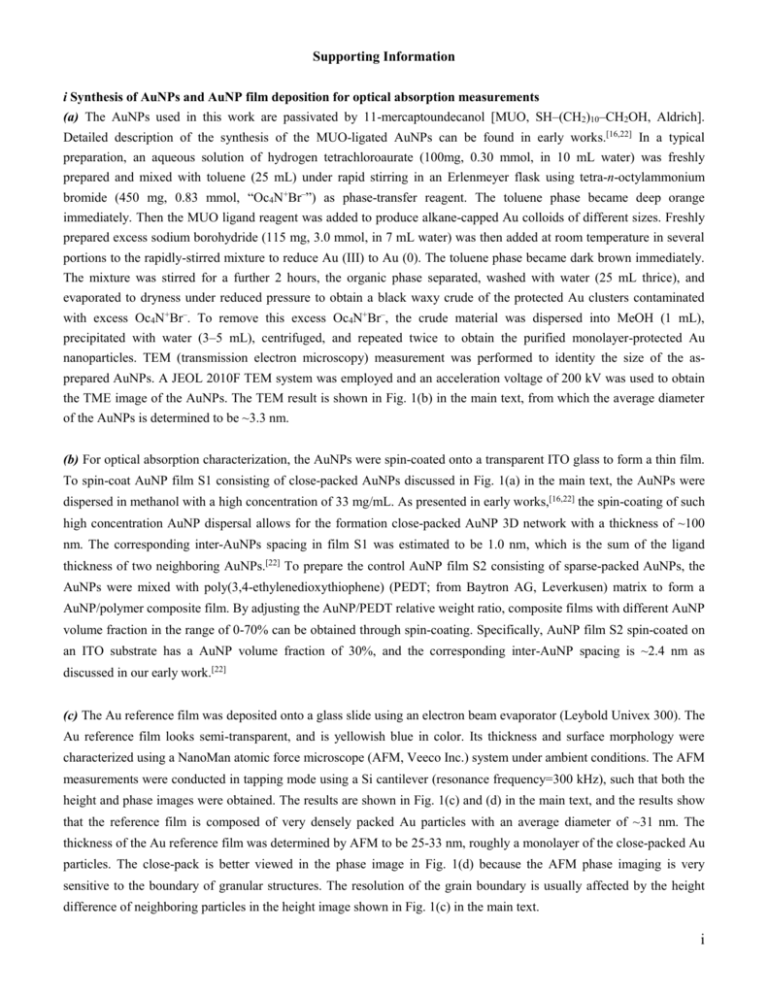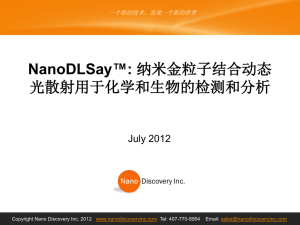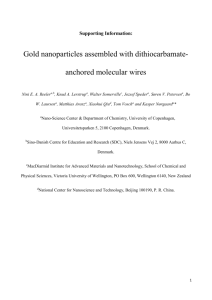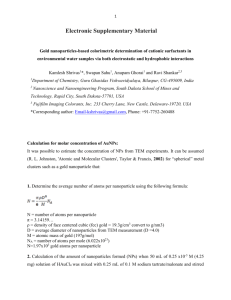Revised Supporting Information
advertisement

Supporting Information i Synthesis of AuNPs and AuNP film deposition for optical absorption measurements (a) The AuNPs used in this work are passivated by 11-mercaptoundecanol [MUO, SH–(CH2)10–CH2OH, Aldrich]. Detailed description of the synthesis of the MUO-ligated AuNPs can be found in early works.[16,22] In a typical preparation, an aqueous solution of hydrogen tetrachloroaurate (100mg, 0.30 mmol, in 10 mL water) was freshly prepared and mixed with toluene (25 mL) under rapid stirring in an Erlenmeyer flask using tetra-n-octylammonium bromide (450 mg, 0.83 mmol, “Oc4N+Br–”) as phase-transfer reagent. The toluene phase became deep orange immediately. Then the MUO ligand reagent was added to produce alkane-capped Au colloids of different sizes. Freshly prepared excess sodium borohydride (115 mg, 3.0 mmol, in 7 mL water) was then added at room temperature in several portions to the rapidly-stirred mixture to reduce Au (III) to Au (0). The toluene phase became dark brown immediately. The mixture was stirred for a further 2 hours, the organic phase separated, washed with water (25 mL thrice), and evaporated to dryness under reduced pressure to obtain a black waxy crude of the protected Au clusters contaminated with excess Oc4N+Br–. To remove this excess Oc4N+Br–, the crude material was dispersed into MeOH (1 mL), precipitated with water (3–5 mL), centrifuged, and repeated twice to obtain the purified monolayer-protected Au nanoparticles. TEM (transmission electron microscopy) measurement was performed to identity the size of the asprepared AuNPs. A JEOL 2010F TEM system was employed and an acceleration voltage of 200 kV was used to obtain the TME image of the AuNPs. The TEM result is shown in Fig. 1(b) in the main text, from which the average diameter of the AuNPs is determined to be ~3.3 nm. (b) For optical absorption characterization, the AuNPs were spin-coated onto a transparent ITO glass to form a thin film. To spin-coat AuNP film S1 consisting of close-packed AuNPs discussed in Fig. 1(a) in the main text, the AuNPs were dispersed in methanol with a high concentration of 33 mg/mL. As presented in early works,[16,22] the spin-coating of such high concentration AuNP dispersal allows for the formation close-packed AuNP 3D network with a thickness of ~100 nm. The corresponding inter-AuNPs spacing in film S1 was estimated to be 1.0 nm, which is the sum of the ligand thickness of two neighboring AuNPs.[22] To prepare the control AuNP film S2 consisting of sparse-packed AuNPs, the AuNPs were mixed with poly(3,4-ethylenedioxythiophene) (PEDT; from Baytron AG, Leverkusen) matrix to form a AuNP/polymer composite film. By adjusting the AuNP/PEDT relative weight ratio, composite films with different AuNP volume fraction in the range of 0-70% can be obtained through spin-coating. Specifically, AuNP film S2 spin-coated on an ITO substrate has a AuNP volume fraction of 30%, and the corresponding inter-AuNP spacing is ~2.4 nm as discussed in our early work.[22] (c) The Au reference film was deposited onto a glass slide using an electron beam evaporator (Leybold Univex 300). The Au reference film looks semi-transparent, and is yellowish blue in color. Its thickness and surface morphology were characterized using a NanoMan atomic force microscope (AFM, Veeco Inc.) system under ambient conditions. The AFM measurements were conducted in tapping mode using a Si cantilever (resonance frequency=300 kHz), such that both the height and phase images were obtained. The results are shown in Fig. 1(c) and (d) in the main text, and the results show that the reference film is composed of very densely packed Au particles with an average diameter of ~31 nm. The thickness of the Au reference film was determined by AFM to be 25-33 nm, roughly a monolayer of the close-packed Au particles. The close-pack is better viewed in the phase image in Fig. 1(d) because the AFM phase imaging is very sensitive to the boundary of granular structures. The resolution of the grain boundary is usually affected by the height difference of neighboring particles in the height image shown in Fig. 1(c) in the main text. i ii Optical absorption measurements The optical absorption measurements were carried out using a UV-3600 spectrophotometer (Shimadzu Scientific Instruments) which is capable of generating monochromatic light in the UV (ultraviolet)-VIS (visible)-NIR (near infrared) region (or 185-3300 nm). The light source consists of one 50 W halogen lamp and one deuterium lam with a built-in lamp auto positioning unit. Grating/grating-type double monochromators were used for the generation of wavelengthspecific light with a resolution of at least 0.8 nm. A photomultiplier tube (R928 equivalent) and an InGaAs photodiode were installed in the system for photodetection in the UV-VIS and NIR region, respectively. The absorption measurements of AuNP films and the Au reference film were performed under ambient conditions, and bare ITO or glass slides were used for baseline correction. The absorption spectra were collected in absorbance mode for all samples. iii Simulation of optical absorption Descrete dipole approximation (DDA) theory and code[35,36] was used to simulate the evolution of optical absorption as a function of AuNP packing density. The ligated AuNP film structure was modeled by assuming a simple cubic packing of NPs in the alkyl ligand medium as shown in the inset of Fig. 2. The radius R of AuNPs was kept constant (R=1.5 nm), while the inter-NP distance L was varied in a wide range of 0-5 nm to mimic the different NP packing density d. The thickness of the NP film was assumed to be 100 nm, while the lateral dimension of the film was set to a few mm. We used the dielectric function of polyethylene to represent that of the alkane ligand because both of the organics have similar saturated hydrocarbon-chain structures. We therefore took n=2 and k=10-4 [37] of polyethylene as the real and imaginary parts of the dielectric function of the ligand in the 300-1500 nm range. ii iv Photocurrent measurements a) To collect the photocurrent results shown in Fig. 3, a commercial 300 W Xe lamp[38] was used as light source, and the production of light was controlled by a digital exposure controller. A cornerstone 260 monochromator was employed as filter to generate photons with a specific wavelength . To determine the -dependent photon flux of the Xe lamp, a calibrated Si photodetector was irradiated by the light of the lamp, and the corresponding photocurrent was recorded. The number N of photons in the photon flux was then calculated using the photocurrent and photoresponsivity of the Si photodetector (see details in Fig. S2). The above light source, monochromator, exposure controller, Si photodetector and wavelength scan software are all components of the Oriel system purchased from Newport Corporation (Irvine, CA, USA). b) To fabricate AuNP devices for photocurrent measurements, the as-prepared AuNPs were deposited onto intrinsic ptype Si substrates (0.1-0.3 S/cm). Then ITO glass (Prazisions Glas & Optik Gmbh, Germany; Square resistance 10 Ω/□) was mechanically pressed onto the AuNP/p-Si film as top electrode to form ITO/AuNPs/p-Si device. Although in ref. 22 we used ITO glass as substrate, and also observed photocurrent generation from the ITO/AuNPs/ITO device, we found that this device configuration does not allow for convenient photocurrent measurements. This is because AuNPs do not spread uniformly on the ITO substrate in the spin-coating process, and consequently we encountered short-circuiting problems when measuring photocurrent. While on the p-Si substrate, large scale (from mm to cm) uniform AuNP film Fig. S1 (a) Optical microscope image of the spin-coated AuNP film on p-Si substrate. (b) Corresponding AFM height image of the AuNP film. can be routinely spin-coated [see Fig. S1 for a typical optical microscope image (a) and AFM height image (b) of the AuNP film on p-Si], and the ITO/AuNPs/p-Si device guarantees stable and reproducible photocurrent characterizations in our experiments. Due to the usage of p-Si as substrate, one may have concerns that the p-Si would also contribute to photocurrent. In Fig. 1(b) of ref. 22, we have performed control experiments using ITO/p-Si and ITO/ligand/p-Si devices respectively, and our results showed that the photocurrent is generated exclusively from the AuNP active layers. Therefore, the photocurrent results reported in this work is based on the ITO/AuNPs/p-Si device. The active area of the device is in the range of 0.2-0.5 cm2. c) For photocurrent measurement of the ITO/AuNPs/p-Si device, a constant bias voltage V (0-5 V) is applied between the ITO and p-Si electrodes. The light generated by the 300 W Xe lamp was normally incident onto the AuNP film through the top ITO glass. When the wavelength was scanned from 300 to 1500 nm, the corresponding photocurrent under a constant bias voltage was recorded using a Keithley 2420 sourcemeter. The measurements were conducted in ambient conditions, and both dark current and photocurrent were collected respectively for comparison. iii d) In addition to previous results shown in ref. 22, we also performed experiments by comparing the photocurrent between the ITO/AuNPs/p-Si and two control devices: pure Au film/p-Si device and ITO/p-Si device. The Au film/p-Si device was fabricated by thermally depositing Au film on p-Si using the Leybold Univex 300 electron-beam evaporator, while the ITO-/p-Si device was made by mechanically pressing the ITO glass on the p-Si surface. The photocurrent was obtained by exposing the three devices respectively to the irradiance of the 300 W Xe lamp while maintaining an identical bias voltage of 5 V to the devices. Fig. S2 displays the photocurrent thus observed for the devices. It can be seen that, in contrast to the current variation as a function of wavelength observed for the ITO/AuNPs/p-Si device, the current obtained for the control devices is constant without photodetection behavior. In addition, the dark current (data not shown here) observed for the control devices is almost the same as the corresponding photocurrent shown in Fig. S2. Since there is no AuNPs used in the control devices, the control experiments further confirm that the origin of photocurrent and photodetection is the AuNPs. Fig. S2 Comparison of photocurrent between the ITO/AuNPs/p-Si device and the Au film/p-Si and ITO/p-Si control devices. The photocurrent was obtained by exposing the three devices respectively to the 300 W Xe lamp while maintain an identical bias voltage of 5 V. iv v Determination of the number N of photons and AuNP photocurrent QY a) The N values of the 300 W Xe lamp at different wavelength shown in Fig. 3(a)-ii in the main text was determined by exposing the calibrated Si photodetector[12] (Newport Corporation, see SI-iv-a) to the lamp light and recording the corresponding photocurrent of the Si detector at zero bias voltage. Fig. S3(a) shows the photocurrent I Si of the commercial Si detector recorded in the 300-1100 nm range. Fig. S3(b) displays the photoresponsivity (a) (b) (c) Fig. S3 (a) Photocurrent of the calibrated Si detector collected in the 300-1100 nm range. (b) The photoresponsivity of the Si detector. (c) Calculated number of photons generated by the 300 W Xe lamp used in the experiments. RS Si of the standard Si photodetector. Based on the photocurrent and photoresponsivity, the number N of I photons of different is calculated using N 5.03 1015 Si ,[38] and is shown in Fig. S3(c). This photon RS Si flux result thus obtained is shown in Fig. 3(a)-ii in the main text. b) The AuNP photocurrent I ph shown in Fig. 3(a)-iii in the main text can be converted to the number N ph e of photoelectrons using the relation N phe 6.24 1018 I ph (in electrons/s). The QY is then calculated using QY N phe N (in photoelectrons/photon) where N is the number of photons in the photon flux generated by the Xe lamp as discussed in Fig. S3(c). The QY results shown in Fig. 3(b)-ii & iii in the main text are based on the above procedures. v vi QY-V plots obtained using individual laser diodes To double-check the photocurrent results obtained using the 300 W Xe lamp, we also performed photocurrent measurements by using individual laser diodes to irradiate the AuNP device. In this case, a green laser diode with =532 nm and a NIR laser diode with =1064 nm were employed, respectively. In a typical measurement, a constant bias voltage of 0-5 V was applied to the device, while the laser light was kept on and off alternatively to obtain the on- and off-current ( I ON and I OFF ). Fig. S4(a) displays the I ON and I OFF observed at V=0, 3, and 5 V, respectively by using the 1064 nm (200 mW) laser diode. The quantum yield QY was calculated using ( I ON I OFF ) 6.24 1018 where P (in W) and (in nm) are the power and wavelength of the photon QY 5.03 1015 P flux. The QY results are displayed as plot-ii in Fig. 4(b) in the main text. Similarly, I ON and I OFF were also recorded by using the 532 nm (at 40 mW) laser diode, and the QY thus obtained for different bias voltages is shown in Fig. S4(b). It can be seen that this QY result is in good agreement with that shown as plot-i in Fig. 2(b) in the main text obtained using the 300 Xe lamp. Fig. S4 (a) On and off photocurrent recorded under a bias voltage of 0, 3, and 5 V respectively by exposing and un-exposing the AuNP device to the light of the 1064 nm laser diode. (b) QY obtained similarly by exposing and un-exposing the AuNP device to the light of the 532 nm laser diode. vi








